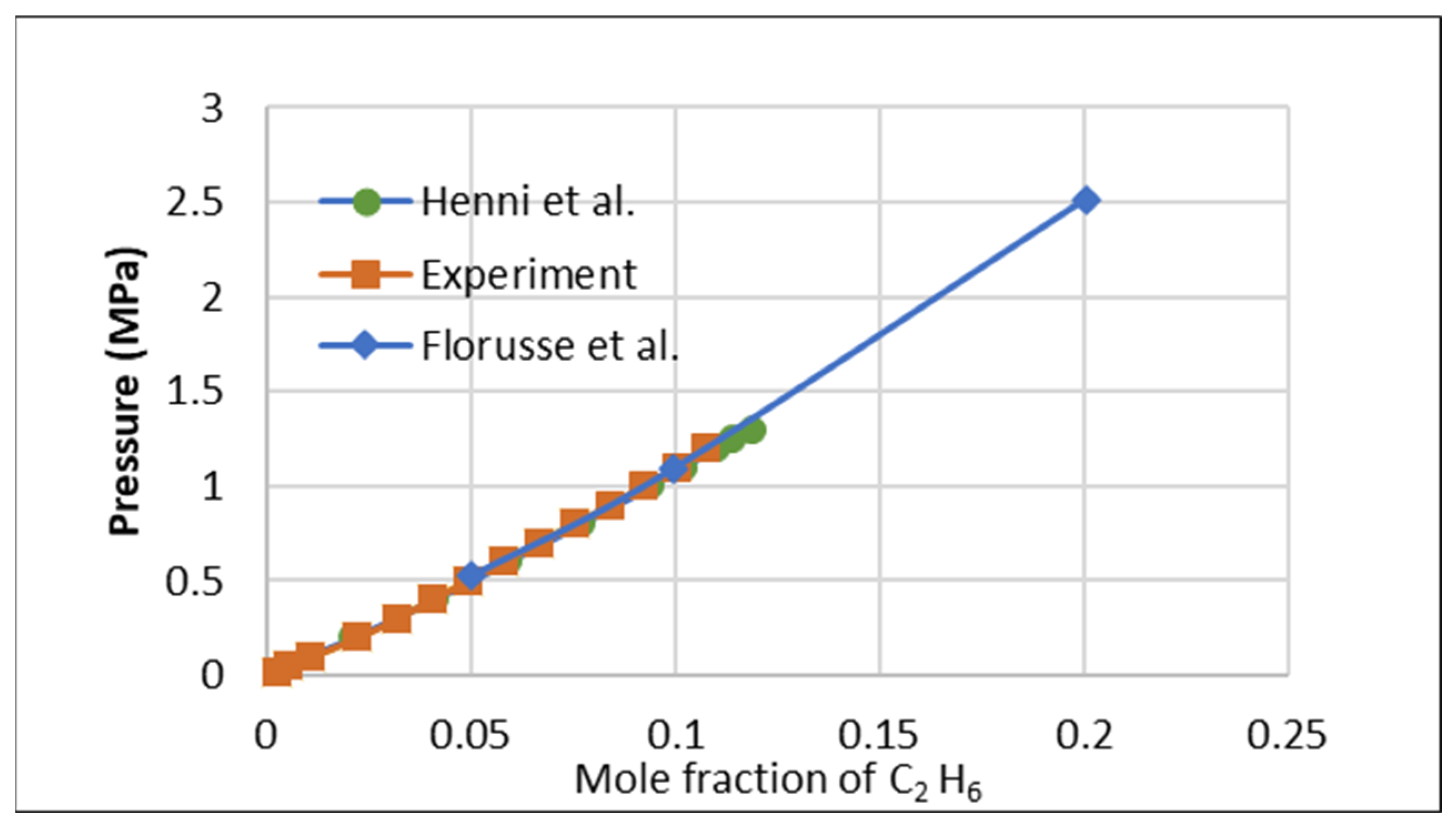Carbon Dioxide Selectivity over Ethane in Promising Bis Tri (Fluoromethylsulfonyl) Imide-Based Ionic Liquids
Abstract
1. Introduction
2. Results
2.1. Ethane (C2H6) Absorption Validation Test
2.2. C2H6 Solubility in Selected ILs
2.3. Interaction Parameters Evaluation from Simulation
- IL-1: vdW1 (3.87%), vdW2 (1.93%), and WS-NRTL (1.96%).
- IL-2: vdW1 (3.63%), vdW2 (1.62%), and WS-NRTL (1.58%).
- IL-3: vdW1 (5.09%), vdW2 (1.58%), and WS-NRTL (1.53%).
2.4. Henry’s Law Constants, Entropies and Enthalpies of Solvation
2.5. Selectivity-CO2/C2H6
3. Discussion
3.1. Temperature Dependence of Ethane Absorption
3.2. Effect of Ionic Liquid Structure on Ethane Absorption
3.3. Alkyl Chain Length
3.4. Cation Effect
3.5. Comparison of Ionic Liquids Based on Henry’s Law Constants
3.6. Comparison to Conventional Solvents
3.7. Implications for Natural Gas Processing
4. Methodology and Materials
4.1. Materials
4.2. Density Evaluation of the ILs
4.3. Ethane Solubility Analysis
4.4. Thermodynamic Simulation and Modelling
- van der Waals one single binary interaction parameter
- van der Waals two binary interaction parameters
- NRTL model combined with Wong-Sandler mixing rules (WS-NRTL)
- van der Waals mixing rules
Wong-Sandler Mixing Rule with NRTL Model (WS-NRTL)
4.5. Critical Properties Calculations
4.6. Optimizing Binary Interaction Parameters
4.7. Henry’s Law Constant, Enthalpy of Absorption, and Entropy of Solvation
5. Conclusions
- The alkyl chain length significantly affects ethane absorption by increasing its nonpolarity. IL-2, with its longer hexadecyl chain, demonstrated the highest solubility capacity, while IL-1, with its shorter alkyl chain, showed the lowest capacity for Ethane. This behavior was confirmed by a molecular simulation study [11].
- The type of cation also influences ethane solubility, but its effect is less pronounced than the alkyl chain length.
- Compared to conventional solvents, the studied ILs exhibit higher ethane absorption, which may limit their use in selective CO2-capture applications without further modifications.
Author Contributions
Funding
Data Availability Statement
Conflicts of Interest
References
- Peng, B.; Zhao, Y.; Elahi, E.; Wan, A. Can third-party market cooperation solve the dilemma of emissions reduction? A case study of energy investment project conflict analysis in the context of carbon neutrality. Energy 2023, 264, 1016. [Google Scholar] [CrossRef]
- Dubey, A.; Arora, A. Advancements in carbon capture technologies: A review. Clean. Prod. 2022, 373, 1016. [Google Scholar] [CrossRef]
- Freemantle, M. Designer solvents-ionic liquids may boost clean technology. Chem. Eng. News Arch. 1998, 76, 17. [Google Scholar] [CrossRef]
- Bahadur, I.; Phadagi, R. Ionic Liquids as Environmental Benign Solvents for Cellulose Chemistry: A Review. Lond. IntechOpen 2019, 1, 173. [Google Scholar]
- Vadillo, J.; Diaz-Sainz, G.; Gomez-Coma, L.; Garea, A.; Irabien, A. Chemical and Physical Ionic Liquids in CO2 Capture Systems Using Membrane Vacuum Regeneration. Membranes 2022, 12, 785. [Google Scholar] [CrossRef] [PubMed]
- Sumon, K.Z.; Henni, A. Ionic liquids for CO2 capture using COSMO-RS: Effect of structure, properties and molecular interactions on solubility and selectivity. Fluid Phase Equilibria 2011, 310, 39–55. [Google Scholar] [CrossRef]
- Quaye, E.; Henni, A.; Shirif, E. Carbon Dioxide Solubility in Three Bis Tri (Fluoromethylsulfonyl) Imide-Based Ionic Liquids. Molecules 2024, 29, 2784. [Google Scholar] [CrossRef] [PubMed]
- Florusse, L.; Peters, S.R.C. High-pressure phase behavior of Ethane with 1-hexyl-3-methylimidazolium bis(trifluoromethylsulfonyl)imide. J. Chem. Eng. Data 2008, 53, 1283–1285. [Google Scholar] [CrossRef]
- Henni, N.; Husameldin, I.; Henni, A. Solubility of Carbon Dioxide in Promising Ionic Liquids. Fluid Phase Equilibria 2022, 565, 1016. [Google Scholar]
- Rayer, A.; Henni, A.; Tontiwachwuthikul, P. High-Pressure Solubility of Methane (CH4) and Ethane (C2H6) in Mixed Polyethylene Glycol Dimethyl Ethers (Genosorb1753) and Its Selectivity in Natural Gas Sweetening Operations. J. Chem. Eng. Data 2012, 57, 764–775. [Google Scholar] [CrossRef]
- Kurnia, K.A.; Matheswaran, P.; How, C.J.; Noh, M.H.; Kusumawati, Y. A comprehensive study on the impact of chemical structures of ionic liquids on the solubility of Ethane. New J. Chem. 2020, 44, 11155–11163. [Google Scholar] [CrossRef]
- Nath, D.; Henni, A. Solubility of carbon dioxide (CO2) in four bis (trifluoromethylsulfonyl)imide ([Tf2N]) based ionic liquids. Fluid Phase Equilibria 2020, 524, 112757. [Google Scholar] [CrossRef]
- Karunarathne, S.; Eimer, D.; Lars, E. Density, Viscosity, and Excess Properties of MDEA + H2O, DMEA + H2O, and DEEA + H2O Mixture. Appl. Sci. 2020, 10, 3196. [Google Scholar] [CrossRef]
- Valderrama, J.; Rojas, R. Critical properties of ionic liquids: Revisited. Ind. Eng. Chem. Res. 2009, 48, 6890–6900. [Google Scholar] [CrossRef]
- Henni, A.; Tagiuri, A.; Nath, D.; Sumon, S. Effect of Cation on the solubility of Ethane in three bis(fluorosulfonyl) Imide (FSI) Based Low viscosity Ionic Liquids. Fluid Phase Equilibria 2017, 454, 78–90. [Google Scholar]
- Huseynov, M. Thermodynamic and Experimental Studies of Ethane Solubility in Promising Ionic Liquids for CO2 Capture. Master’s Thesis, University of Regina, Regina, SK, Canada, 2015. [Google Scholar]


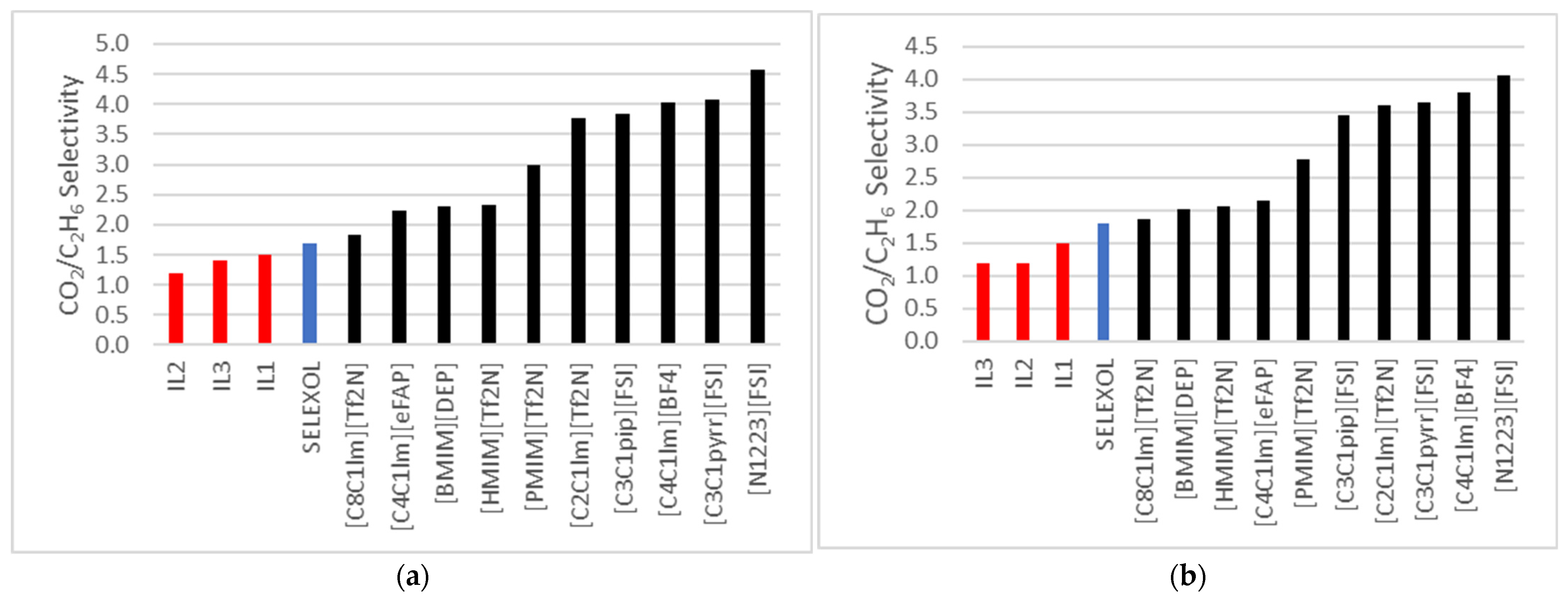
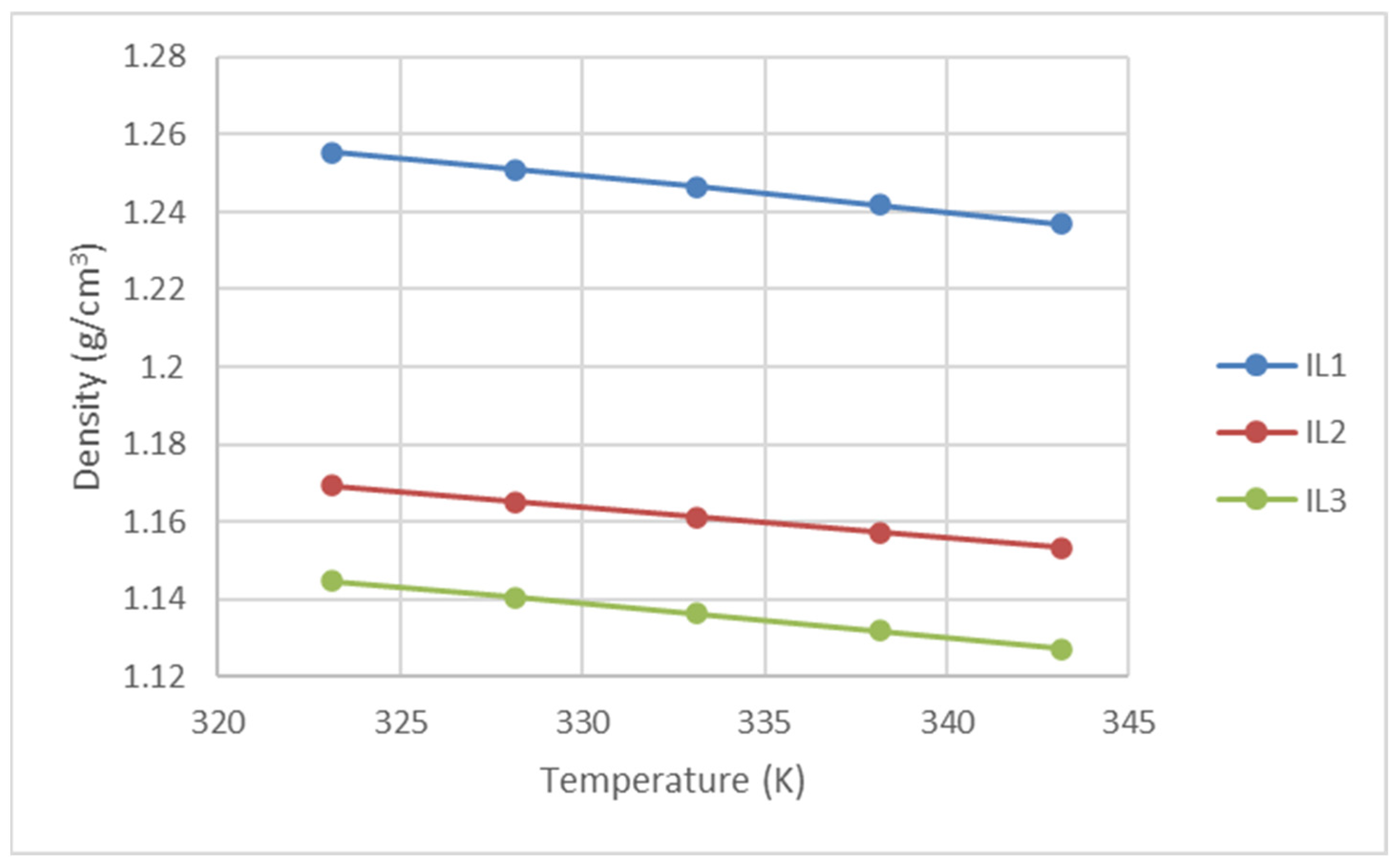
| (a) IL-1 | |||||
| 303.15 K | 323.15 K | 343.15 K | |||
| xC2H6 | Pressure (MPa) | xC2H6 | Pressure (MPa) | xC2H6 | Pressure (MPa) |
| 0.021 | 0.0999 | 0.018 | 0.0999 | 0.014 | 0.0999 |
| 0.040 | 0.1998 | 0.034 | 0.1992 | 0.026 | 0.1920 |
| 0.059 | 0.3000 | 0.048 | 0.2987 | 0.038 | 0.2978 |
| 0.078 | 0.3990 | 0.061 | 0.3994 | 0.049 | 0.4001 |
| 0.095 | 0.4989 | 0.074 | 0.5002 | 0.060 | 0.4993 |
| 0.112 | 0.6021 | 0.087 | 0.5987 | 0.071 | 0.6001 |
| 0.129 | 0.7029 | 0.103 | 0.7306 | 0.082 | 0.7036 |
| 0.145 | 0.8000 | 0.110 | 0.7994 | 0.092 | 0.7990 |
| 0.161 | 0.8900 | 0.124 | 0.8995 | 0.103 | 0.9000 |
| 0.176 | 1.0034 | 0.139 | 0.9998 | 0.113 | 1.0004 |
| 0.188 | 1.0999 | 0.152 | 1.0993 | 0.123 | 1.1000 |
| 0.199 | 1.2000 | 0.166 | 1.1993 | 0.132 | 1.2000 |
| (b) IL-2 | |||||
| 323.15 K | 333.15 K | 343.15 K | |||
| xC2H6 | Pressure (MPa) | xC2H6 | Pressure (MPa) | xC2H6 | Pressure (MPa) |
| 0.024 | 0.0999 | 0.020 | 0.0999 | 0.018 | 0.0999 |
| 0.046 | 0.1998 | 0.037 | 0.1992 | 0.036 | 0.2001 |
| 0.067 | 0.3000 | 0.055 | 0.2987 | 0.054 | 0.3002 |
| 0.088 | 0.3990 | 0.070 | 0.3994 | 0.071 | 0.3999 |
| 0.107 | 0.4990 | 0.084 | 0.5002 | 0.088 | 0.4998 |
| 0.126 | 0.6021 | 0.099 | 0.5987 | 0.104 | 0.6026 |
| 0.145 | 0.7029 | 0.117 | 0.7306 | 0.119 | 0.7020 |
| 0.163 | 0.8000 | 0.125 | 0.7994 | 0.133 | 0.7999 |
| 0.181 | 0.8900 | 0.140 | 0.8995 | 0.146 | 0.8890 |
| 0.197 | 1.0034 | 0.156 | 0.9998 | 0.161 | 1.0014 |
| 0.210 | 1.1000 | 0.171 | 1.0993 | 0.174 | 1.0991 |
| 0.222 | 1.2000 | 0.186 | 1.1993 | 0.188 | 1.1997 |
| (c) IL-3 | |||||
| 303.15 K | 323.15 K | 343.15 K | |||
| xC2H6 | Pressure (MPa) | xC2H6 | Pressure (MPa) | xC2H6 | Pressure (MPa) |
| 0.026 | 0.0997 | 0.023 | 0.0999 | 0.022 | 0.0999 |
| 0.052 | 0.1999 | 0.044 | 0.1995 | 0.036 | 0.1989 |
| 0.077 | 0.3005 | 0.063 | 0.3010 | 0.051 | 0.3005 |
| 0.101 | 0.3989 | 0.081 | 0.4001 | 0.067 | 0.4007 |
| 0.123 | 0.4996 | 0.098 | 0.4996 | 0.080 | 0.4998 |
| 0.144 | 0.6012 | 0.115 | 0.5996 | 0.094 | 0.5997 |
| 0.164 | 0.6998 | 0.131 | 0.7009 | 0.107 | 0.7002 |
| 0.183 | 0.7999 | 0.148 | 0.8008 | 0.123 | 0.8006 |
| 0.206 | 0.9013 | 0.162 | 0.9007 | 0.136 | 0.8998 |
| 0.220 | 1.0001 | 0.176 | 1.0006 | 0.147 | 1.0002 |
| 0.237 | 1.0996 | 0.196 | 1.1235 | 0.160 | 1.0989 |
| 0.253 | 1.2020 | 0.208 | 1.2155 | 0.171 | 1.2036 |
| (a) | |||||||
| Ionic Liquids + C2H6 | Temperature (°C) | Binary Interaction Parameter (k12) | % AAD | ||||
| IL-1 | 30 | 0.0251 | 3.16 | ||||
| 50 | 0.0175 | 4.65 | |||||
| 70 | 0.0076 | 3.82 | |||||
| IL-2 | 50 | −0.0619 | 3.68 | ||||
| 60 | −0.0486 | 5.15 | |||||
| 70 | −0.0779 | 2.08 | |||||
| IL-3 | 30 | −0.0180 | 3.60 | ||||
| 50 | −0.0316 | 5.43 | |||||
| 70 | −0.0452 | 6.25 | |||||
| (b) | |||||||
| Ionic Liquids + C2H6 | Temperature (°C) | Binary Interaction Parameter | % AAD | ||||
| (k12) | (l12) | ||||||
| IL-1 | 30 | 0.0639 | 0.0081 | 1.05 | |||
| 50 | 0.0962 | 0.0165 | 3.13 | ||||
| 70 | 0.1003 | 0.0178 | 1.63 | ||||
| IL-2 | 50 | −0.0203 | 0.0090 | 1.05 | |||
| 60 | 0.0260 | 0.0161 | 3.06 | ||||
| 70 | −0.0412 | 0.0072 | 0.77 | ||||
| IL-3 | 30 | 0.0186 | 0.0066 | 0.91 | |||
| 50 | 0.0423 | 0.0131 | 1.27 | ||||
| 70 | 0.0385 | 0.0143 | 2.58 | ||||
| (c) | |||||||
| Ionic Liquids + C2H6 | Temperature (°C) | Binary Interaction Parameter | % AAD | ||||
| (k12) | (τ12) | (τ21) | |||||
| IL-1 | 30 | 0.8971 | 2.9264 | −1.1653 | 1.05 | ||
| 50 | 1.1539 | −0.5388 | 0.2736 | 3.19 | |||
| 70 | 1.1676 | −0.5310 | 0.2201 | 1.64 | |||
| IL-2 | 50 | 0.8093 | 0.0347 | −0.5349 | 1.05 | ||
| 60 | 0.8842 | −0.7371 | 0.3785 | 2.96 | |||
| 70 | 0.8040 | 0.5633 | −0.9996 | 0.73 | |||
| IL-3 | 30 | 0.9710 | 0.6134 | −0.8364 | 0.75 | ||
| 50 | 0.9978 | −0.4426 | 0.0021 | 1.28 | |||
| 70 | 0.9771 | −0.4671 | 0.0060 | 2.56 | |||
| Ionic Liquid (ILs) | (MPa) | (kJ/mol) | (kJ/Kmol·K) | ||
|---|---|---|---|---|---|
| IL-1 | T = 30 °C | T = 50 °C | T = 70 °C | ||
| 4.80 | 5.70 | 7.28 | −8.97 | −27.92 | |
| IL-2 | T = 50 °C | T = 60 °C | T = 70 °C | ||
| 4.13 | 4.98 | 5.21 | −10.79 | −32.33 | |
| IL-3 | T = 30 °C | T = 50 °C | T = 70 °C | ||
| 4.58 | 5.29 | 6.35 | −7.04 | −21.89 | |
| Temperature (K) | IL-1 | IL-2 | IL-3 |
|---|---|---|---|
| IL-1 & IL-3 at 303.15|IL-2 at 323.15 | 1.7 | 1.2 | 1.7 |
| IL-1 & IL-3 at 323.15 K|IL-2 at 333.15 | 1.5 | 1.3 | 1.4 |
| 343.15 | 1.5 | 1.2 | 1.2 |
| Average Selectivity | 1.6 | 1.2 | 1.4 |
| Ionic Liquid | Chemical Formula | Acronym | Chemical Structure |
|---|---|---|---|
| 1-Decyl-3-methylimidazolium bis (trifluoromethylsulfonyl imide) (≥98.0%) | C15H26F6N3O4S2 | IL-1 | 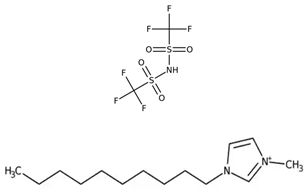 |
| 1-Hexadecyl-3-methyl imidazolium bis (trifluoromethylsulfonyl imide) (≥98.0%) | C21H40F6N3O4S2 | IL-2 |  |
| Triethyl tetradecyl ammonium bis (trifluoromethylsulfonyl imide) (≥98.0%) | C20H44F6N2O4S2 | IL-3 | 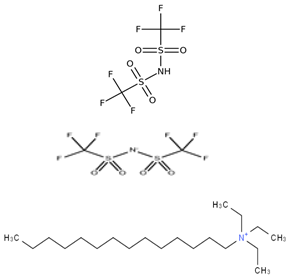 |
| Temperature (K) | Density (g/cm3) | ||
|---|---|---|---|
| IL-1 | IL-2 | IL-3 | |
| 303.15 | 1.2727 | - | 1.1608 |
| 308.15 | 1.2684 | - | 1.1569 |
| 313.15 | 1.2640 | - | 1.1529 |
| 318.15 | 1.2597 | - | 1.1488 |
| 323.15 | 1.2553 | 1.1693 | 1.1446 |
| 328.15 | 1.2510 | 1.1652 | 1.1405 |
| 333.15 | 1.2465 | 1.1612 | 1.1362 |
| 338.15 | 1.2418 | 1.1572 | 1.1317 |
| 343.15 | 1.2368 | 1.1532 | 1.1270 |
| Component | Tc (K) | Pc (Bar) | ω |
|---|---|---|---|
| IL-1 | 1345.1 | 18.700 | 0.5741 |
| IL-2 | 1195.4 | 18.347 | 0.9176 |
| IL-3 | 1207.7 | 14.265 | 1.1367 |
| C2H6 | 305.4 | 48.8 | 0.099 |
Disclaimer/Publisher’s Note: The statements, opinions and data contained in all publications are solely those of the individual author(s) and contributor(s) and not of MDPI and/or the editor(s). MDPI and/or the editor(s) disclaim responsibility for any injury to people or property resulting from any ideas, methods, instructions or products referred to in the content. |
© 2025 by the authors. Licensee MDPI, Basel, Switzerland. This article is an open access article distributed under the terms and conditions of the Creative Commons Attribution (CC BY) license (https://creativecommons.org/licenses/by/4.0/).
Share and Cite
Quaye, E.; Henni, A.; Shirif, E. Carbon Dioxide Selectivity over Ethane in Promising Bis Tri (Fluoromethylsulfonyl) Imide-Based Ionic Liquids. Molecules 2025, 30, 984. https://doi.org/10.3390/molecules30050984
Quaye E, Henni A, Shirif E. Carbon Dioxide Selectivity over Ethane in Promising Bis Tri (Fluoromethylsulfonyl) Imide-Based Ionic Liquids. Molecules. 2025; 30(5):984. https://doi.org/10.3390/molecules30050984
Chicago/Turabian StyleQuaye, Eric, Amr Henni, and Ezeddin Shirif. 2025. "Carbon Dioxide Selectivity over Ethane in Promising Bis Tri (Fluoromethylsulfonyl) Imide-Based Ionic Liquids" Molecules 30, no. 5: 984. https://doi.org/10.3390/molecules30050984
APA StyleQuaye, E., Henni, A., & Shirif, E. (2025). Carbon Dioxide Selectivity over Ethane in Promising Bis Tri (Fluoromethylsulfonyl) Imide-Based Ionic Liquids. Molecules, 30(5), 984. https://doi.org/10.3390/molecules30050984






